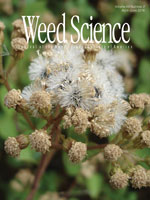Palmer amaranth is a highly invasive weed species causing huge economic losses in agricultural cropping systems under a broad range of environmental conditions. Sensitivity of this species to ozone (O3) air pollution and to soil water deficit, relative to native species or competing crops, may affect its competitiveness and invasive potential. In recent years, both high tropospheric O3 and soil water deficiency have become common in the San Joaquin Valley of California. Responses to these environmental parameters may help predict the invasiveness of this species and have implications for landscape hydrology. We assessed the impact of O3 and soil water deficit on Palmer amaranth. Five- to seven-leaf–stage potted plants were placed in continuous stirred tank reactor chambers and maintained for 30 to 35 d under 12-h mean daylight O3 exposures (0700–1900 hours) of 4, 59, or 114 ppb O3. Within the chambers the plants were either well-watered (WW) or exposed to regulated deficit irrigation (RDI) and grown for about 7 wk. Dry weights of the leaves, stems, roots, and leaf area were determined. Day- and nighttime stomatal conductances (gs) were measured at 1.5-h intervals. Nocturnal gs was about 16 to 29% of daytime gs; this suggests that the species could have substantial nighttime water loss, uncoupled from carbon gain in the weed, and could affect water availability for crops and reduce irrigation efficiency. Nocturnal gs was lower in the RDI than in the WW, but daytime gs was not affected by O3 or irrigation regime. Neither O3 nor irrigation regime affected root or shoot parameters. As O3 and drought are two key stressors in the San Joaquin Valley, to which potential competing species have been found to be sensitive, Palmer amaranth may proliferate and become more invasive in the future, potentially altering landscape hydrology and reducing irrigation efficiency.
Nomenclature: Palmer amaranth, Amaranthus palmeri S. Wats.





